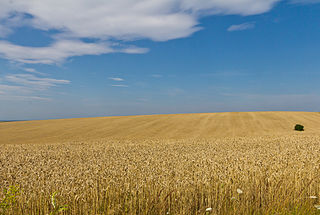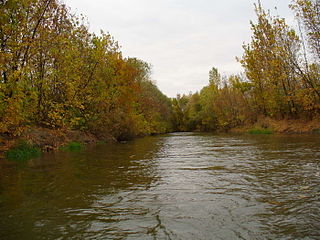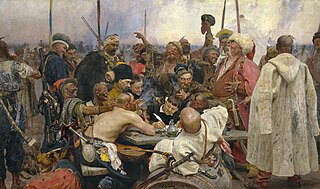
Ukraine is the second-largest European country, after Russia. Its various regions have diverse geographic features ranging from highlands to lowlands, as well as climatic range and a wide variety in hydrography. Most of the country lies within the East European Plain.

The Sea of Azov is an inland shelf sea in Eastern Europe connected to the Black Sea by the narrow Strait of Kerch, and sometimes regarded as a northern extension of the Black Sea. The sea is bounded by Russia on the east, and by Ukraine on the northwest and southwest. It is an important access route for Central Asia, from the Caspian Sea via the Volga–Don Canal.

Azov, previously known as Azak , is a town in Rostov Oblast, Russia, situated on the Don River just 16 kilometers (9.9 mi) from the Sea of Azov, which derives its name from the town. The population is 81,924 (2021 Census); 82,937 (2010 Census); 82,090 (2002 Census); 80,297 (1989 Soviet census).

Berdiansk or Berdyansk is a port city in Zaporizhzhia Oblast, south-eastern Ukraine. It is on the northern coast of the Sea of Azov, which is connected to the Black Sea. It serves as the administrative center of Berdiansk Raion. The city is named after the Berda River's Berdiansk Spit, at the foot of which it is located. Its population is 106,311.

The Azov campaigns of 1695–1696 were two Russian military campaigns during the Russo-Turkish War of 1686–1700, led by Peter the Great and aimed at capturing the Turkish fortress of Azov with the aim of controlling the southern mouth of the Don River gaining access to the Sea of Azov and entrance to the Black Sea. Despite stubborn resistance and heavy casualties, the Russians under General Sheremetev after a failed siege in 1695 managed to capture the fort, accompanied by a naval force, in July 1696, marking the first major Russian victory against the Turks.

The Russo-Turkish War of 1735–1739 between Russia and the Ottoman Empire was caused by the Ottoman Empire's war with Persia and the continuing raids by the Crimean Tatars. The war also represented Russia's ongoing struggle for access to the Black Sea. In 1737, the Habsburg monarchy joined the war on Russia's side, known in historiography as the Austro-Turkish War of 1737–1739.

The Arabat Spit or Arabat Arrow is a barrier spit that separates the large, shallow, salty Syvash lagoons from the Sea of Azov. The spit runs between the Henichesk Strait in the north and the north-eastern shores of Crimea in the south. It is the largest of several spits of the Sea of Azov.

The Mius is a river in Eastern Europe that flows through Ukraine and Russia. It is 258 kilometres (160 mi) long, and has a drainage basin of 6,680 square kilometres (2,580 sq mi).

Black Sea Cossack Host, also known as Chernomoriya, was a Cossack host of the Russian Empire created in 1787 in southern Ukraine from former Zaporozhian Cossacks. In the 1790s, the host was re-settled to the Kuban River. It comprised the Caucasus Fortified Defence Line from the mouth of the Kuban River to the mouth of the Bolshaya Laba River.

Azov Cossack Host was a Cossack host that existed on the northern shore of the Sea of Azov, between 1832 and 1862.

The Syvash or Sivash, also known as the Putrid Sea or Rotten Sea, is a large area of shallow lagoons on the western edge of the Sea of Azov. Separated from the sea by the narrow Arabat Spit, the water of the Syvash covers an area of around 2,560 km2 (990 sq mi) and the entire area spreads over about 10,000 km2 (3,900 sq mi). The Henichesk Strait is its eastern connection to the Sea of Azov. The Syvash borders the northeastern coast of the main Crimean Peninsula. The central and eastern Syvash were registered as wetlands of Ukraine under the Ramsar Convention. Since the 2022 Russian invasion of Ukraine, the entire Syvash has been occupied by Russia.

The Azov Flotilla or Azov Naval Flotilla was the name given to several Russian naval forces operated on the Sea of Azov - as part of the Imperial Russian Navy, by both the Workers' and Peasants' Red Fleet and the White Russians during the Russian Civil War of 1917 to 1923, and as part of the Soviet Navy during World War II.

Azov Governorate was an administrative-territorial unit (guberniya) of the Russian Empire, which existed from 1775 to 1783. Its capital was in Belyov Fortress and later in Yekaterinoslav.

Pryazovia or literally Cis-Azov region is usually used to refer to the geographic area of the north coast of the Sea of Azov, mostly located in south-eastern Ukraine, with a small part in Russia. It is located in the southern part of the Azov-Kuban Lowland within the East European Plain, which surrounds the Sea of Azov for most of the stretch of coastline. In a more general sense it may mean the Azov Sea littoral, and conversely, to be more specific, it may also be referred to as the Northern Priazovye.

United Nations General Assembly Resolution 68/262 was adopted on 27 March 2014 by the sixty-eighth session of the United Nations General Assembly in response to the Russian annexation of Crimea and entitled "territorial integrity of Ukraine". The nonbinding resolution, which was supported by 100 United Nations member states, affirmed the General Assembly's commitment to the territorial integrity of Ukraine within its internationally recognized borders and underscored the invalidity of the 2014 Crimean referendum. Eleven nations voted against the resolution, while 58 abstained, and a further 24 states were absent when the vote took place.

The 12th Special Operations Brigade "Azov" is a formation of the National Guard of Ukraine formerly based in Mariupol, in the coastal region of the Sea of Azov, from which it derives its name. It was founded in May 2014 as the Azov Battalion, a self-funded volunteer militia under the command of Andriy Biletsky, to fight Russian-backed forces in the Donbas War. It was formally incorporated into the National Guard on 11 November 2014, and redesignated Special Operations Detachment "Azov", also known as the Azov Regiment. In February 2023, the Ukrainian Ministry of Internal Affairs announced that Azov was to be expanded as a brigade of the new Offensive Guard.
The Treaty Between the Russian Federation and Ukraine on Cooperation in the Use of the Sea of Azov and the Kerch Strait is an agreement on sea and fisheries between Russia and Ukraine entered into force on 23 April 2004. It was signed on 24 December 2003 by President of Ukraine Leonid Kuchma and President of Russia Vladimir Putin and ratified by both parliaments in April 2004.

The Kerch Strait incident was an international incident that occurred on 25 November 2018 in the Kerch Strait, during which the Russian Federal Security Service (FSB) coast guard fired upon and captured three Ukrainian Navy vessels after they attempted to transit from the Black Sea into the Sea of Azov through the strait on their way to the port of Mariupol. It was the first time that Russian forces had openly engaged Ukrainian forces during the Russo-Ukrainian War.

A dispute over Tuzla Island in the Kerch Strait arose between Russia and Ukraine in 2003, sparked by unannounced Russian construction of a causeway from their side of the strait toward the island, which is Ukrainian territory. Russians offered various reasons for building the causeway, but Ukraine saw it as a threat to their territorial integrity. The dispute raised fears of an armed confrontation, but a settlement was negotiated.

















